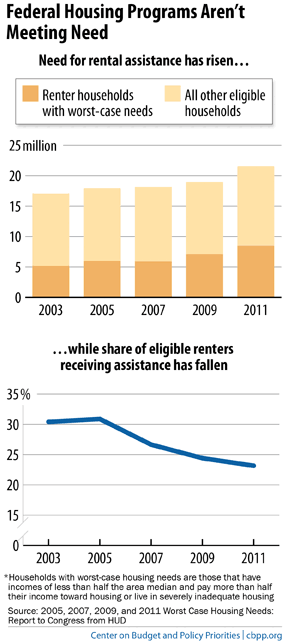BEYOND THE NUMBERS
Housing has become increasingly unaffordable for many Americans, especially those with the lowest incomes, as a recent report from Harvard’s Joint Center for Housing Studies documents and I pointed out earlier this week. And federal policy is helping fewer families meet this challenge. The number of households experiencing “worst-case needs” — those with very low incomes that pay more than half their income toward housing or live in severely inadequate housing — has risen dramatically, but the share of households eligible for assistance that receive it has fallen to just 23 percent (see chart).

These trends have significant negative consequences for low-income families, as Harvard’s report details. To afford housing, they may be forced to live in neighborhoods with high crime rates or in inadequate housing. Families that pay more than half their income for housing also spend far less on other basic needs, including 39 percent less on food, 65 percent less on health care, and 66 percent less on transportation, than families with affordable housing.
Federal rental assistance is a lifeline that can help prevent those kinds of negative results for low-income families. About 5 million low-income households receive assistance to afford decent, stable, modest housing while paying about 30 percent of their income toward rent. Rental assistance programs reduce poverty, homelessness, and housing instability, and help families afford decent quality housing in safer neighborhoods.
Nevertheless, Congress has cut these programs in recent years. Between 2010 and 2014, Congress cut funding for Housing Choice Vouchers by $528 million, public housing by almost $1.6 billion, and housing for the elderly and people with disabilities by almost $600 million, adjusted for inflation. These cuts have kept tens of thousands of eligible families from receiving rental assistance. As we’ve explained, for example, last year’s sequestration cuts dropped the number of families using Housing Choice Vouchers by more than 70,000.
Unfortunately, Congress may provide little relief in the 2015 budget. While Congress provided sufficient funding in 2014 to restore half of the vouchers lost to sequestration, the 2015 spending bills that the House recently approved and the Senate may consider this summer fail to renew those restored vouchers. Congress can and should do more to help low-income families live in safe and affordable homes.
